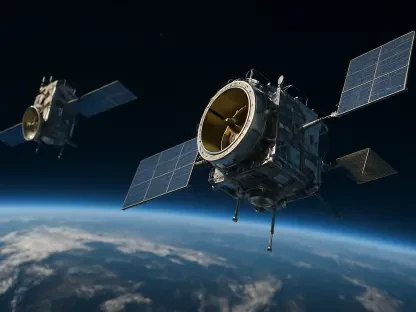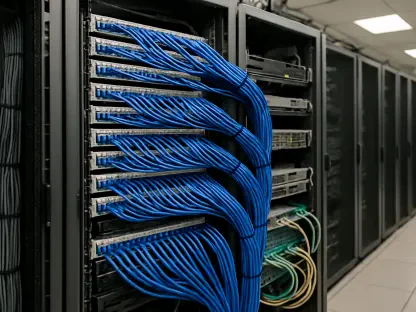In an era where digital transformation is reshaping the industrial landscape, Europe is carving out a bold path to secure its future through a federated cloud-edge continuum, a strategy deeply intertwined with the principles of Industry 4.0. This ambitious endeavor goes beyond merely enhancing cloud infrastructure or tightening data security; it’s about orchestrating a complex ecosystem of multi-vendor, multi-network environments to ensure seamless performance for cutting-edge industrial applications. Major initiatives like IPCEI-CIS (Important Project of Common European Interest for Next-Generation Cloud Infrastructure & Services) and 8RA are at the helm, uniting over 100 organizations across the continent, including Reply Adeptic, an Italian firm under the Reply group. These efforts aim to build a sovereign, interoperable cloud-edge framework that prioritizes scalability, resilience, and autonomy for European industries. The ultimate goal is to reduce reliance on non-European tech giants, enabling industries to operate independently in an increasingly interconnected global market. Yet, the journey is fraught with challenges, from managing a chaotic mix of connectivity technologies to aligning diverse stakeholders around a shared vision. With a timeline stretching over a decade, the scale of this transformation is immense, but the potential to position Europe as a leader in industrial digitalization makes it a pursuit worth exploring.
Strategic Vision for Digital Sovereignty
Defining Sovereignty in the Digital Age
Digital sovereignty in today’s context extends far beyond the realm of data protection, encompassing comprehensive control over network technologies and industrial operations critical to Europe’s economic independence. This concept is a cornerstone of initiatives like IPCEI-CIS and 8RA, which are designed to minimize dependency on external tech providers, particularly those outside the European sphere. By fostering an environment where industries can operate autonomously, these programs aim to shield European businesses from vulnerabilities tied to geopolitical shifts or foreign influence over critical infrastructure. The emphasis on sovereignty reflects a strategic imperative to ensure that industrial processes remain secure and resilient in a globalized economy where digital dominance often dictates competitive advantage. This multidimensional approach signals a shift in how Europe perceives its role in the digital landscape, prioritizing self-reliance as a non-negotiable element of progress.
In the pursuit of digital sovereignty, Europe is redefining how industrial data and connectivity are managed within its borders, moving beyond merely reacting to external pressures. Instead, the region is proactively building frameworks that enable localized control over technological ecosystems. This includes developing policies and infrastructure that support data storage, processing, and network management on European soil, while adhering to stringent regulatory standards. Such measures are not just about protectionism but about creating a robust foundation for innovation that aligns with European values and priorities. The long-term vision is to cultivate a digital environment where industries can thrive without the constant threat of external disruptions, setting a precedent for how sovereignty can be achieved in an interconnected world.
Collaborative Efforts and Federation
A federated approach lies at the heart of Europe’s strategy, recognizing that digital sovereignty cannot be achieved through isolated efforts but through widespread collaboration among diverse entities. With over 100 organizations participating in initiatives like IPCEI-CIS and 8RA, there is a clear commitment to building a unified ecosystem that balances European autonomy with global competitiveness. This collective effort brings together vendors, integrators, operators, and cloud providers, each contributing expertise to create a cohesive digital infrastructure. The focus on federation ensures that no single entity dominates the landscape, instead fostering an environment of shared responsibility and mutual benefit. This collaborative spirit is essential for tackling the scale of challenges involved, from technical integration to policy alignment.
Beyond the immediate technical goals, federation serves as a mechanism to strengthen Europe’s position on the global stage by promoting a model of cooperation over competition within its borders. By pooling resources and knowledge, these initiatives aim to create a cloud-edge ecosystem that rivals those of major international players while adhering to European standards of privacy and security. The collaborative framework also helps in distributing the financial and operational burdens of such a massive undertaking, making it feasible for smaller entities to contribute meaningfully. As a result, this approach not only enhances technological capabilities but also builds a sense of unity and shared purpose among European stakeholders, paving the way for sustained innovation and resilience in the industrial sector.
Technical Foundations and Challenges
Navigating Complex Network Environments
Modern industrial settings in Europe are characterized by an intricate blend of connectivity technologies, each serving distinct purposes yet requiring seamless integration to function effectively. Private 5G networks deliver ultra-low latency for real-time applications, while Wi-Fi ensures robust indoor coverage, and LoRaWAN supports IoT sensor communications across vast areas. Non-terrestrial networks, such as satellite systems, provide critical connectivity for remote operations, complemented by fixed infrastructure like Ethernet and fiber-to-the-x (FTTx) for local and backhaul needs. Managing this diverse array of technologies across multiple sites, providers, and domains presents a significant challenge, often likened to untangling a web of overlapping systems. Without a unified approach, the risk of inefficiencies and disruptions looms large, threatening the performance of mission-critical industrial processes.
The complexity of these network environments is further compounded by the need to maintain consistent performance across varied geographic and operational contexts. Industrial facilities often span multiple regions, each with unique connectivity requirements and regulatory constraints, adding layers of difficulty to the task of integration. Ensuring that data flows smoothly between different network types—such as transitioning a robot’s connection from 5G to Wi-Fi without interruption—demands sophisticated solutions capable of handling dynamic conditions. This intricate landscape underscores the urgency for advanced orchestration tools that can harmonize disparate systems into a cohesive whole, enabling industries to leverage the full potential of their technological investments without being hindered by connectivity bottlenecks.
Multi-Network Orchestration as the Backbone
At the core of Europe’s cloud-edge strategy is the concept of multi-network orchestration, a process designed to coordinate distributed computing and connectivity resources across diverse environments with precision. Platforms like the one developed by Reply Adeptic exemplify this approach, engineered to manage multi-vendor, multi-cloud, and multi-network deployments at scale. This orchestration capability ensures portability, allowing applications and workloads to shift between environments with minimal friction, a critical feature for maintaining operational continuity in dynamic industrial settings. By creating a federated ecosystem where resources are allocated efficiently, such platforms address the fundamental need for integration, enabling disparate systems to work as a unified entity. This forms the technological backbone of Europe’s vision for industrial autonomy.
The significance of orchestration extends beyond technical integration to strategic alignment with broader Industry 4.0 goals. It facilitates the seamless interaction of various network technologies, ensuring that industrial applications—whether in manufacturing plants or logistics hubs—experience consistent performance regardless of the underlying infrastructure. This capability is vital for scaling operations across multiple sites and adapting to fluctuating demands, such as sudden spikes in data traffic or shifts in resource availability. Moreover, orchestration platforms incorporate mechanisms for real-time monitoring and adjustment, providing industries with the agility to respond to challenges as they arise. As Europe pushes forward with its digital transformation, the role of orchestration as a unifying force becomes increasingly indispensable, bridging gaps between technology and practical application.
Role of AI in Dynamic Management
Artificial intelligence (AI) stands as a transformative force within Europe’s cloud-edge ecosystem, driving efficiency and adaptability across the orchestration process from planning to execution. In the initial stages, AI aids in site selection and resource planning, analyzing vast datasets to determine optimal configurations for industrial deployments. During runtime, it enables dynamic network adaptation, adjusting parameters in real time to maintain performance under varying conditions, such as fluctuating latency or device mobility. Additionally, AI’s predictive maintenance capabilities help anticipate potential disruptions, issuing alerts to prevent downtime before issues escalate. This intelligence ensures that complex industrial environments remain resilient and scalable, even as demands evolve.
The integration of AI into lifecycle management also optimizes workload distribution across distributed clusters, ensuring resources are utilized efficiently and bottlenecks are minimized. By automating decision-making processes that would otherwise require extensive human intervention, AI allows for a level of precision and speed unattainable through manual methods. This is particularly crucial in scenarios where split-second decisions can impact operational outcomes, such as in autonomous vehicle systems or high-speed manufacturing lines. Furthermore, AI-driven insights contribute to long-term planning by identifying trends and patterns that inform future infrastructure investments. As industrial environments grow increasingly intricate, the role of AI in maintaining equilibrium and driving innovation becomes a cornerstone of Europe’s strategy, ensuring that technological advancements translate into tangible operational benefits.
Implementation and Industry Impact
Addressing Interoperability Hurdles
Interoperability remains a formidable barrier to realizing a fully integrated cloud-edge ecosystem across Europe, with the absence of standardized interfaces and shared data models often impeding seamless collaboration among vendors, operators, and cloud providers. Without common frameworks, systems struggle to communicate effectively, leading to inefficiencies and fragmented operations that undermine the broader goals of digital sovereignty. Initiatives like IPCEI-CIS are stepping in to address this challenge by fostering alignment around unified standards and open-source practices, ensuring that orchestration functions consistently across diverse digital landscapes. The push for interoperability is not just a technical necessity but a strategic priority, as it underpins the ability to create a cohesive network capable of supporting Europe’s industrial ambitions.
Achieving interoperability also requires overcoming the inherent diversity in technological approaches and proprietary systems that dominate the current market, a challenge that is critical to creating a seamless digital ecosystem. Many stakeholders operate with customized solutions tailored to specific needs, which, while effective in isolation, create friction when integrated into a larger ecosystem. Efforts to develop shared protocols and data models are crucial in bridging these gaps, enabling disparate systems to interact as if they were designed together from the outset. This process involves rigorous testing and validation to ensure compatibility across different environments, a task that demands both time and resources. As Europe works toward these goals, the success of interoperability initiatives will determine the extent to which the cloud-edge continuum can deliver on its promise of unified, efficient, and autonomous industrial operations.
Real-World Industrial Applications
The practical impact of multi-network orchestration and AI-driven systems is vividly illustrated in specific industrial sectors such as manufacturing, transportation, and autonomous vehicles, where seamless connectivity is paramount. In manufacturing, robots on factory floors rely on uninterrupted handovers between private 5G and Wi-Fi networks to maintain precision and efficiency during complex assembly processes. Similarly, logistics hubs leverage LoRaWAN for IoT sensor networks, with satellite backups ensuring connectivity in remote locations, thus optimizing supply chain operations. These real-world applications demonstrate how Europe’s cloud-edge advancements translate into tangible benefits, enhancing operational reliability and enabling industries to meet the demands of modern markets with greater agility.
In the transportation sector, particularly with rail systems and autonomous vehicles, the integration of edge computing and orchestrated networks plays a critical role in ensuring safety and efficiency. Rail signaling systems, for instance, utilize edge computing resources to process data locally, reducing latency and improving response times for critical operations. Autonomous vehicles, meanwhile, depend on dynamic network adjustments to navigate varying conditions, relying on AI to manage connectivity across urban and rural environments. These use cases highlight the transformative potential of Europe’s technological push, showing how coordinated systems can address specific industry challenges. By tailoring solutions to meet the unique needs of each sector, the cloud-edge ecosystem not only boosts performance but also sets a benchmark for innovation in industrial applications.
Long-Term Roadmap and Commitment
The timeline for implementing Europe’s cloud-edge strategy stretches over a decade, encompassing phases of research, industrialization, and full-scale deployment, reflecting the vast scope and complexity of this transformative project. Spanning multiple countries, network domains, and industry verticals, the initiative requires sustained commitment to navigate potential disruptions, whether political, economic, or technological. The extended duration underscores the reality that building a sovereign digital infrastructure is not a quick fix but a long-term endeavor demanding coordination at every level. This roadmap serves as a reminder of the patience and perseverance needed to achieve a vision that redefines industrial connectivity across the region, ensuring that each phase builds on the successes of the previous one.
Maintaining momentum over such a prolonged period also necessitates adaptability to evolving circumstances, as technological landscapes and global dynamics are bound to shift. Continuous investment in research and development is essential to keep pace with emerging innovations, while regular reassessments of goals and strategies help address unforeseen challenges. Collaboration among stakeholders must remain a priority to prevent fragmentation, ensuring that resources and expertise are aligned toward common objectives. The commitment to this long-term vision is a testament to Europe’s determination to secure its industrial future, recognizing that the benefits of enhanced efficiency, scalability, and autonomy in operations will only be realized through persistent effort and unified action across diverse domains.
Cultural and Commercial Dimensions
Aligning Diverse Stakeholders
Beyond the realm of technology, one of the most significant challenges facing Europe’s cloud-edge initiative is the cultural and commercial alignment of diverse stakeholders, each with distinct priorities and perspectives that often clash. Vendors, operators, and cloud providers frequently operate under differing interpretations of standards, leading to friction that can stall progress toward a unified operational framework. This misalignment is not merely a logistical issue but a barrier rooted in competing business interests and historical practices that resist harmonization. Addressing these differences requires ongoing dialogue and negotiation to build trust and establish common ground, ensuring that all parties see value in contributing to a shared ecosystem rather than pursuing individual agendas.
The process of alignment also involves navigating the complexities of regulatory environments and market dynamics that vary across European regions, creating a challenging landscape for collaboration. Some stakeholders may prioritize short-term gains over long-term collaboration, which can create tension within the broader initiative. To counter this, structured forums and working groups under initiatives like IPCEI-CIS play a vital role in facilitating communication, allowing for the resolution of conflicts and the development of mutually beneficial strategies. By fostering an environment where cultural and commercial differences are acknowledged and addressed, Europe can move closer to achieving the cohesion necessary for a sovereign cloud-edge continuum. This effort, though challenging, is indispensable for turning a fragmented landscape into a unified force capable of driving industrial innovation.
Building Consensus for Success
Consensus-building emerges as a critical factor in realizing Europe’s vision for a sovereign cloud-edge ecosystem, as the risk of fragmentation looms large without a shared understanding and commitment among stakeholders. Disparities in goals and operational approaches can lead to inefficiencies, undermining the potential of even the most advanced technological solutions. Initiatives like 8RA are instrumental in this regard, providing platforms for stakeholders to align on common practices and objectives, from technical standards to strategic priorities. This process is not just about agreement on paper but about cultivating a collective mindset that values the long-term benefits of collaboration over short-term differences, ensuring that the ecosystem functions as a cohesive whole.
The importance of consensus extends to the adoption of standardized interfaces and data models, which are pivotal for seamless integration across diverse systems. Without a unified approach, the vision of a federated cloud-edge continuum risks becoming a patchwork of incompatible solutions, unable to deliver the scalability and resilience Europe seeks. Building this consensus requires persistent effort to address concerns, share best practices, and demonstrate the tangible advantages of a collaborative framework. As Europe navigates these cultural and commercial nuances, the success of its digital transformation hinges on the ability to forge a unified path forward, ensuring that the ambitious goals set for industrial sovereignty are not derailed by division but strengthened through collective resolve.
Reflecting on Transformative Milestones
Looking back, Europe’s journey toward a federated cloud-edge ecosystem marked a pivotal chapter in the region’s industrial history, as initiatives like IPCEI-CIS and 8RA laid critical groundwork for digital sovereignty. The orchestration of heterogeneous networks, powered by AI-driven automation, tackled the complexities of modern industrial environments with remarkable ingenuity, setting new standards for efficiency and resilience. Reply Adeptic’s contributions, through its multi-tiered platform, exemplified the technical innovation needed to bridge disparate systems into a unified whole. Despite hurdles in interoperability and stakeholder alignment, the persistent push for standardized frameworks and a collaborative spirit fostered progress that reshaped how industries operated. Moving forward, the focus should shift to accelerating the adoption of these technologies across sectors, investing in continuous innovation to stay ahead of global trends, and strengthening cross-border partnerships to maintain momentum. By prioritizing these actionable steps, Europe can solidify its position as a frontrunner in industrial digitalization, ensuring that the legacy of this transformative effort endures for future generations.









